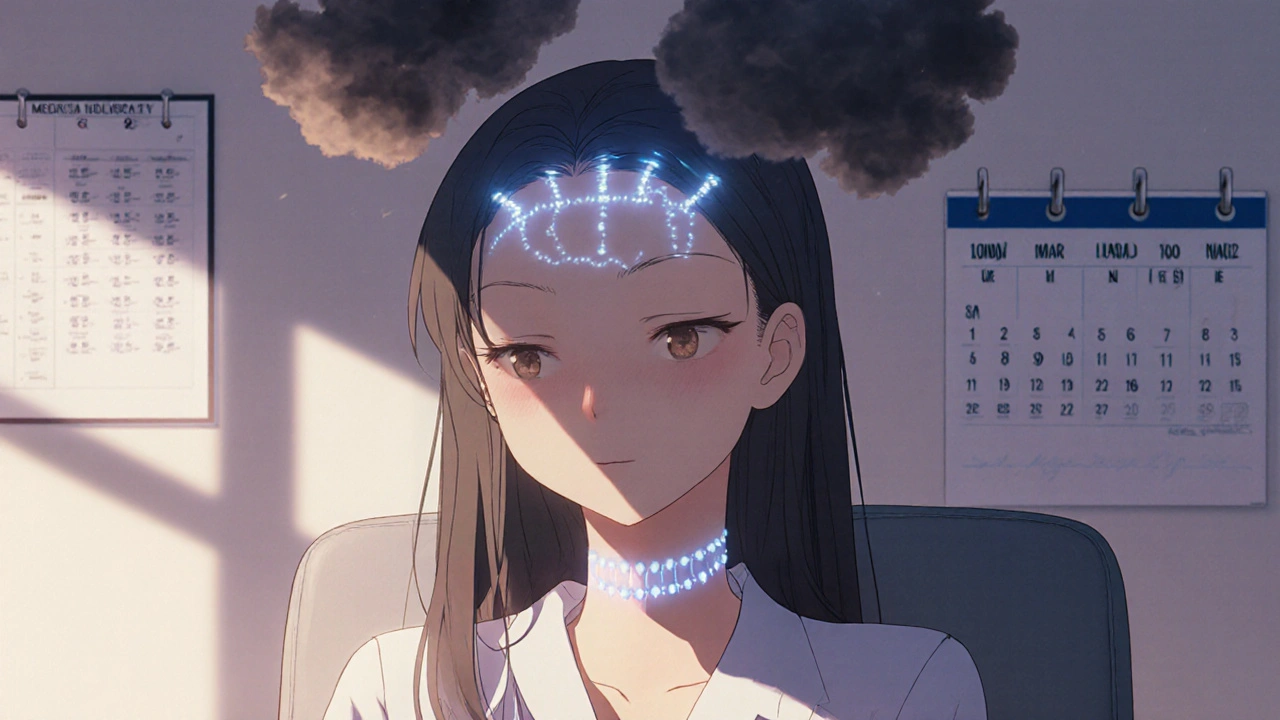If you're one of the millions who suffer from chronic migraines-15 or more headache days a month, with at least eight of them being full-blown migraines-you know how exhausting it is. Medications that work for others might leave you dizzy, nauseous, or worse. That’s where Botox comes in. Not the cosmetic kind you see on social media, but a medically approved treatment that’s been changing lives for people with chronic migraine since 2010.
How Botox Stops Migraines Before They Start
Botox, or onabotulinumtoxinA, is a purified form of botulinum toxin from the bacterium Clostridium botulinum. It’s not a painkiller. It doesn’t numb your head or block pain signals like a triptan does. Instead, it works deeper-on the nerves that trigger migraines.
When injected into specific muscles in the head and neck, Botox blocks the release of chemicals like CGRP (calcitonin gene-related peptide), which spikes during a migraine attack. It also reduces inflammation around nerves and interrupts the way pain signals travel from the brain to the face and scalp. Think of it like turning down the volume on a noisy speaker instead of plugging your ears.
Studies show it doesn’t just calm muscles-it affects sensory nerves too. This is why it’s not used for occasional headaches. It’s designed for people whose brains have become hypersensitive over time, where even normal triggers like light or stress can set off a migraine storm.
Who Actually Benefits From Botox for Migraine?
Not everyone with migraines gets relief from Botox. The FDA approved it only for chronic migraine, meaning 15 or more headache days per month, with at least eight meeting migraine criteria. If you get migraines only 4-6 days a month, Botox likely won’t help.
The best candidates are people who’ve tried at least three other preventive medications-like topiramate, propranolol, or amitriptyline-and couldn’t stick with them due to side effects. Many of these patients also have medication-overuse headache, where daily painkillers make migraines worse over time.
Real-world data from over 1,200 patients shows that 63% of chronic migraine sufferers cut their headache days by half or more after a year of Botox. For some, it’s even better: one patient went from 25 migraine days a month down to just 8-10. Their worst attacks became manageable instead of debilitating.
People with more than 20 headache days per month tend to see the biggest absolute drop in frequency. But even those with 15-18 days benefit significantly. The key is consistency-you need at least three treatment cycles before you know if it’s working.
The Injection Process: What to Expect
The treatment follows a strict protocol called PREEMPT. It’s not random. There are 31 to 39 tiny injections spread across seven areas: forehead, between the eyebrows, temples, back of the head, neck, and shoulders. Each session takes about 15 minutes. No anesthesia is needed, but some people feel a pinch or mild sting.
Most people report no downtime. You can drive yourself home. But about 18% feel soreness at the injection sites, and 7% get temporary weakness in the forehead or neck muscles-enough to raise eyebrows slightly differently for a few weeks. That’s rare and usually fades.
It’s not a one-and-done deal. Treatments happen every 12 weeks, like clockwork. Missing a session can reduce effectiveness. And here’s the catch: it takes time. Only 39% feel major improvement after the first round. By the third or fourth cycle, 61% see their best results.

How It Compares to Other Treatments
Let’s compare Botox to other migraine preventives:
- Topiramate: Effective, but causes brain fog, tingling, weight loss, and kidney stones. One in three people quit because of side effects.
- Propranolol: Can cause fatigue, low blood pressure, and depression. Not safe for people with asthma or certain heart conditions.
- CGRP monoclonal antibodies (like Aimovig, Emgality): Newer, injected monthly, highly effective. But they cost $6,000-$8,000 a year and aren’t always covered by insurance.
- Botox: No daily pills. No liver or kidney strain. Side effects are mild and localized. But you need to visit a specialist every three months.
Researched data shows Botox has a 47% responder rate-meaning nearly half of patients cut their migraine days by half. That’s higher than propranolol (35%) and topiramate (38%), and close to CGRP drugs (52%).
What’s unique? Botox doesn’t affect your whole body. It’s localized. That makes it safer for people with other health issues-like high blood pressure, liver disease, or pregnancy planning.
Cost, Insurance, and Accessibility
A single Botox treatment runs $1,500 to $1,800. That’s $6,000-$7,200 a year. But here’s the good news: 85% of major U.S. insurers cover it for chronic migraine-if you meet the criteria.
Insurance usually requires proof you’ve tried and failed at least three oral preventives. You’ll need to keep a headache diary for three months. Some insurers still fight it, requiring prior authorization. Patients report delays of weeks or even months getting approved.
It’s not cheap, but for many, it’s cheaper than the cost of missed work, ER visits, and daily painkillers. One patient told me she used to spend $200 a month on triptans and pain meds. After Botox, that dropped to $20. She saved $2,000 a year.

What Patients Really Say
On patient forums, Botox gets a 3.8 out of 5 stars. The praise? “I can finally plan a weekend.” “I haven’t called in sick in over a year.” “My kids don’t have to tiptoe around me anymore.”
The complaints? “Insurance denied me twice.” “I felt weird after the injections.” “It worked the first time, then stopped.”
Some people get inconsistent results. That’s often tied to who gives the injections. Studies show injector experience affects outcomes by up to 30%. A board-certified neurologist trained in the PREEMPT protocol does it right 90% of the time. A general dermatologist or aesthetic provider? Maybe 60%.
Always ask: “Are you certified in the PREEMPT protocol for migraine?” If they don’t know what you’re talking about, find someone else.
What’s New in 2025?
In 2023, the FDA expanded Botox’s approval to teens aged 12-17 with chronic migraine. A study showed a 7.8-day drop in monthly headaches for teens on Botox versus 4.2 days for placebo.
Doctors are now combining Botox with CGRP antibodies-and seeing even better results. One trial showed a 68% response rate when both were used together, compared to 51% with either alone.
Researchers are testing longer-lasting versions of Botox that could last 16-20 weeks instead of 12. That could mean fewer visits and lower overall cost.
Future goals? Tailoring injections to individual migraine patterns. Not everyone’s pain starts in the same place. Personalized injection maps could boost effectiveness even more.
Is Botox Right for You?
Ask yourself these questions:
- Do I have 15+ headache days a month, with at least 8 being migraines?
- Have I tried at least three oral preventives and couldn’t tolerate them?
- Do I want to avoid daily pills or injections every month?
- Am I willing to commit to appointments every 12 weeks for at least 6-12 months?
If you answered yes to all four, Botox might be worth exploring. Talk to a headache specialist-not your general neurologist, not your aesthetic clinic. Find someone who treats migraines full-time.
It’s not a cure. But for many, it’s the difference between surviving and living.
Can Botox stop a migraine once it starts?
No. Botox is only for prevention. It doesn’t work like a triptan or gepant, which target active migraine attacks. If you need relief during a migraine, you still need acute medications. Botox reduces how often those attacks happen, not how bad they feel when they strike.
How long does it take for Botox to start working for migraines?
Most people don’t feel full benefits until after the second or third treatment cycle-around 6 to 9 months. Some notice small improvements after the first round, but the biggest drops in headache days usually happen after 12 weeks of the third treatment. Patience is key.
Is Botox safe for long-term use?
Yes. Over 12 years of real-world use show no serious safety concerns. The most common side effects are mild: neck pain, headache, or temporary eyelid droop. These fade within weeks. No evidence suggests long-term nerve or muscle damage. It’s considered safe for ongoing use as long as you’re monitored by a specialist.
Can I use Botox if I’m pregnant or breastfeeding?
There isn’t enough data to say it’s completely safe during pregnancy or breastfeeding. Most doctors won’t start treatment during this time. But if you’re already on Botox and become pregnant, many specialists advise continuing-since stopping could trigger a rebound in migraines, which carries its own risks. Always consult your neurologist and OB-GYN together.
Do I need to stop other migraine meds before starting Botox?
No. You can keep taking your acute medications (like triptans or gepants) while on Botox. Some patients even combine Botox with CGRP monoclonal antibodies for better results. But if you’re on oral preventives like topiramate or beta-blockers, your doctor may taper those slowly after Botox starts working. Never stop a medication without medical supervision.
If you’ve been stuck in the cycle of migraines and failed medications, Botox offers a real alternative. It’s not magic. But for those who’ve tried everything else, it’s one of the few treatments backed by solid science, real patient results, and decades of safety data.








vinod mali
November 16, 2025 AT 23:39Botox for migraines is legit. I've been doing it for 2 years now. Used to have 20 days a month. Now it's 5-6. No more panic when the sun comes up. No more canceling plans. Life changed.
Robert Merril
November 17, 2025 AT 16:52so u mean to say u inject poison in ur head and call it medicine lmao
Rob Goldstein
November 19, 2025 AT 11:29Robert, it’s not poison-it’s a highly purified neurotoxin used in microdoses to modulate nerve signaling. Think of it like a precision tool, not a sledgehammer. The key is the PREEMPT protocol and an experienced injector. If you’re skeptical, check the 12-year safety data from the CDC and FDA. Thousands of chronic migraine patients have been on it long-term with zero systemic toxicity. It’s not magic, but it’s science.
And yes, it’s FDA-approved for chronic migraine specifically-not for occasional headaches. If you’re getting 15+ headache days a month and triptans or topiramate wrecked your brain or made you tired all the time, this is one of the few options that doesn’t make you feel like a zombie.
Noel Molina Mattinez
November 20, 2025 AT 01:44you people are so gullible they inject botulism into your skull and you call it treatment its just a way for pharma to make money
Christina Abellar
November 20, 2025 AT 07:29My mom tried this after 10 years of failed meds. She went from 22 days a month to 9. No more ER trips. No more lying in the dark for days. It’s not perfect but it’s real.
Ashley Unknown
November 20, 2025 AT 10:50They’re hiding the truth. Botox is a cover-up for the real cause: 5G towers and chemtrails. The FDA doesn’t want you to know that migraines are caused by government mind-control beams, and Botox just masks the symptoms while they keep poisoning the water supply. I know someone who stopped Botox and started drinking lemon water with Himalayan salt and her migraines vanished overnight. They don’t want you to know this because it’s cheaper than their billion-dollar drugs. Wake up.
My neighbor’s cousin’s yoga teacher saw a video from a guy in Romania who said the injections were actually tracking devices. I’ve been researching this for 3 years. They’re using botulinum as a Trojan horse. The 12-year safety data? Fabricated. The studies? Paid for by Allergan. They own the neurologists. They own the insurance companies. They own your doctor’s conscience.
I used to believe in science. Now I believe in truth. And the truth is: if you’re still getting Botox, you’re part of the experiment. I’m not saying you’re dumb. I’m saying you’re being used.
They’ll tell you it’s safe. But what’s safe about injecting a neurotoxin into your brain’s communication network? What if it accumulates? What if it affects your gut microbiome? What if it’s linked to the rise in autism? No one’s asking these questions because the money’s too big.
Don’t trust the system. Find the real cause. It’s not in your head. It’s in the sky.
Kathy Grant
November 22, 2025 AT 05:25I read this whole thing and cried a little. Not because it’s sad-but because I finally feel seen. For years I thought I was just weak. That I wasn’t trying hard enough. I tried everything: magnesium, acupuncture, biofeedback, ketogenic diets, even meditation apps that said ‘just breathe and your pain will dissolve.’
Then I got diagnosed with chronic migraine. And I realized-I didn’t need to fix my mind. I needed to fix my nervous system. Botox didn’t make me ‘normal.’ But it gave me back the ability to exist without bracing for the next storm.
It’s not glamorous. It’s not viral. No one posts about their 31-injection appointment on Instagram. But I showed up. I kept going. And after the third round, I slept through the night for the first time in five years.
If you’re reading this and you’re tired-don’t give up. The system is broken. Insurance is a nightmare. But you are not broken. You are a survivor. And you deserve relief.
Find a headache specialist. Not a general neurologist. Not a dermatologist who does Botox for wrinkles. Find someone who’s done this for 10 years. Ask them about PREEMPT. Ask them how many patients they’ve treated. Ask them if they’ve ever seen someone go from 25 days to 8.
Because that person? That’s you.
Jennie Zhu
November 23, 2025 AT 02:30It is imperative to underscore that the efficacy of onabotulinumtoxinA in the management of chronic migraine is predicated upon strict adherence to the PREEMPT protocol, which mandates precise anatomical targeting of seven distinct musculotendinous regions. Deviation from this paradigm results in suboptimal outcomes, as evidenced by multiple randomized controlled trials published in Cephalalgia and Neurology. Furthermore, the pharmacokinetic profile of this agent precludes systemic absorption beyond therapeutic thresholds, thereby preserving its favorable safety profile in long-term administration. It is not a panacea, nor is it a replacement for acute abortive therapy; rather, it functions as a neuromodulatory prophylactic agent with a distinct mechanism of action vis-à-vis CGRP antagonists and beta-blockers.
Insurance denials remain a significant barrier to access, particularly for patients who lack comprehensive headache histories or who reside in regions with limited specialist availability. Collaborative care models involving neurologists, pain specialists, and patient advocates are essential to mitigate these disparities.
Abdul Mubeen
November 23, 2025 AT 06:48How can you trust a treatment that requires you to be injected with a deadly bacterium? The FDA approved it because they’re paid off. The same people who said smoking was safe said this was safe. You think they care about you? They care about profit. You’re a walking wallet. And the fact that you’re still taking it proves you’re too lazy to find the real solution. Maybe your migraines are caused by gluten, or mold, or your phone. But no, you’d rather get poison in your head and call it science.
Georgia Green
November 24, 2025 AT 09:15i got botox last year after 7 yrs of migraines. first round did nothing. second round better. third round i felt like me again. now i only get 3-4 days a month. it took time. but it worked. dont give up.
Roberta Colombin
November 25, 2025 AT 23:18Thank you for sharing this. I’m from a country where migraine is still seen as ‘just a headache.’ Many people don’t believe chronic migraine is real. I wish more doctors here knew about Botox. I hope this post helps someone in India, or Nigeria, or Brazil, who’s suffering alone. You are not alone. There is help. It’s not easy to find, but it exists.
Dave Feland
November 27, 2025 AT 13:54Let’s be honest-Botox for migraines is the pharmaceutical industry’s masterpiece of manipulation. They took a toxin used for assassinations in Cold War spy novels and repackaged it as ‘medical innovation.’ The FDA approval? A bureaucratic rubber stamp. The real reason it works? It numbs the sensory nerves so thoroughly that your brain stops registering pain signals entirely. But what’s the long-term cost? What happens when your trigeminal system becomes desensitized to the point of permanent neural dampening? No one’s studying that. Why? Because no one wants to admit they turned a neurotoxin into a lifelong dependency. This isn’t medicine. It’s chemical pacification.